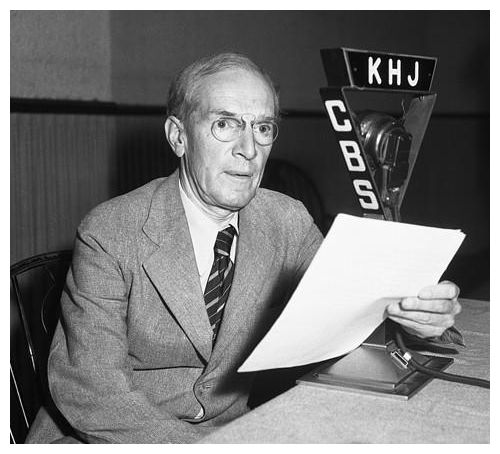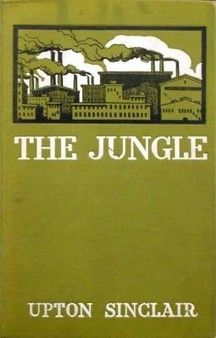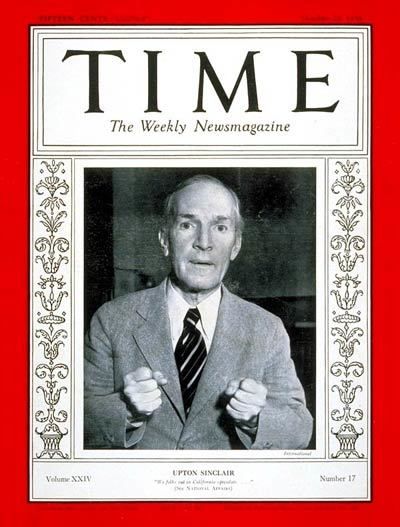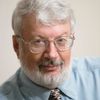
Upton Sinclair broadcasting a radio address during his 1934 campaign for governor of California
Upton Sinclair may have been the most influential American radical during the first half of the 20th century. Today, we should not only celebrate his birthday (September 20, 1878), but also celebrate his remarkable impact on American culture and politics. In its obituary in 1968, the New York Times observed that Sinclair “was that rarity in the literary world, a man of action as well as of ideas.” Many of his ideas, considered radical in his day, are viewed as common sense today. We all stand on his shoulders. But we can’t stand on his statue, because none exists. Nor are there any schools, streets, parks, or public buildings named after this remarkable figure.
Although he is best known as the author of The Jungle (1906), a novel that inspired the nation’s first consumer protection laws, he was a major public figure throughout the first half of the previous century, and his legacy endures. That best-selling book also reminded Americans of the hard work done by immigrants, who then — as now — faced discrimination, bigotry, and exploitation by ruthless employers and abusive police and slumlords. He wrote over 90 books, many of them best sellers. His books exposing the corruption and political influence of big banks, the oil industry, the coal conglomerates, the auto companies, media barons, organized religion, higher education, and other powerful institutions parallel contemporary critiques of these sectors of our society. His nearly-successful left-wing campaign for governor of California in 1934 — a Socialist running as a Democrat, whose party leaders sought his defeat — not only pushed FDR’s New Deal to the left but also foreshadowed Bernie Sanders’ recent presidential crusade. His key role in advocating for free speech — as a early leader of the American Civil Liberties Union — reminds us of today’s efforts to challenge those who seek to stifle dissent.
“I aimed at the public’s heart,” said Sinclair, “and by accident hit its stomach.” Sinclair was referring to the response to his novel The Jungle, about conditions in Chicago’s meatpacking industry. The best-selling book focused on the horrible working and living conditions that immigrant workers and their families faced in the “Packinghouse” area of Chicago. Sinclair portrayed the grueling life of Lithuanian immigrant Jurgis Rudkus, whose backbreaking job in the slaughterhouse and miserable slum housing nearby almost destroys his soul as well as his body. But readers focused instead on Sinclair’s graphic descriptions of the unsanitary process by which animals became meat products. The public outrage triggered by the book—based on Sinclair’s two-month visit to Chicago during a bitter stockyard strike in 1904—led Congress to pass the Pure Food and Drug Act and the Meat Inspection Act in 1906, the first federal laws regulating corporate responsibility for consumer products.
Born into a comfortable Baltimore, Maryland, family, Sinclair entered City College of New York at age fifteen. He began writing sketches—mostly adventure stories—for magazines to pay his expenses. After graduation, he became a full-time writer. His first novel, Springtime and Harvest (1901), was a modest success.
Around this time Sinclair began reading the writings of Karl Marx and the radical economist Thorstein Veblen and joined Eugene Debs’s three-year-old Socialist Party. J. A. Wayland, the editor of the Appeal to Reason, a socialist newspaper with a nationwide circulation of more than 250,000, challenged Sinclair to write a novel about “wage slavery.” So Sinclair headed to Chicago to investigate conditions in the meatpacking industry. A handful of powerful companies controlled the industry, using their political influence to keep the government off their backs. Livestock from midwestern farms were sent to company pens in Chicago, slaughtered, and packed into consumer products. The companies recruited immigrants from Eastern and Central Europe who performed backbreaking work in filthy and dangerous conditions. Many workers stood all day on floors covered with blood, meat scraps, and foul water. They worked six days a week, ten hours a day, and earned pennies an hour.
In The Jungle, Sinclair turned his observations into the gruesome details of Jurgis’s daily life in Chicago’s slums and slaughterhouses. He described workers falling into open cooking vats, amputated fingers being ground into sausage, and diseased cattle being hit with sledgehammers and processed through the slaughterhouses. In one scene, he describes the infiltration of rats:
“There would be meat stored in great piles in rooms; and the water from leaky roofs would drip over it, and thousands of rats would race about on it. It was too dark in these storage places to see well, but a man could run his hand over these piles of meat and sweep off handfuls of the dried dung of rats. These rats were nuisances, and the packers would put poisoned bread out for them; they would die, and then rats, bread, and meat would go into the hoppers together.”
Sinclair serialized his story in the Appeal to Reason and then published the series as a book. It sold 100,000 copies in the first year and was quickly translated into seventeen languages. It even led to a brief upsurge in vegetarianism. President Theodore Roosevelt, who had seen soldiers die from eating rotten meat during the Spanish-American War, invited Sinclair to the White House and pushed Congress to pass the first consumer safety laws.

The Jungle helped inspire a movement among reform-minded journalists to expose the corruption of corporate robber barons, wealthy industrialists, greedy bankers, and their political puppets. Described as “muckrakers,” this first generation of investigative reporters, photographers, reformers, and researchers — including Ida Tarbell, Lincoln Stephens, Lewis Hine, Ida Wells, Louis Brandeis, and Frances Perkins — worked closely with unions, consumer groups, civil rights organizations, progressive politicians and others to change public opinion and change the laws.
The Jungle turned Sinclair into a national celebrity. He used the money from the book to start what he hoped would be a socialist experiment in communal living. He purchased a former boys’ school in Englewood, New Jersey, and renamed it Helicon Hall. Although many famous people—William James, Emma Goldman, Lincoln Steffens, and John Dewey among them—visited Helicon Hall, newspapers wrote scandalous stories about it, gossiping about “free love” experiments that were probably fiction. In March 1907 the building mysteriously burned down.
Sinclair lost his money, but he kept writing at a hectic pace. In The Metropolis (1908), he described the morally bankrupt social world of New York’s fashionable rich. In The Moneychangers, published the same year, he used fiction to attack financier J. P. Morgan. (J.P. Morgan Chase remains one of the world’s most powerful financial institutions. Its current $28 million-a-year CEO, James Dimon, is a worthy successor to J.P. Morgan as an influential corporate plutocrat and target of today’s bank reform activists).
In 1913 and 1914, Sinclair traveled three times to Colorado’s coal fields to investigate corporate titan John D. Rockefeller’s abuse of his workers. In 1914, he helped organize protests at Rockefeller’s Standard Oil headquarters in New York City. In King Coal (1917), he wrote about the Ludlow Massacre, where Rockefeller’s coal empire called out the state militia and private thugs to put down a coal miners strike by killing twenty people, both workers and members of their families.
Sinclair’s The Profits of Religion (1917) is an incendiary attack on organized religion. The Brass Check (1920) indicted the American newspaper business and its business-friendly journalism. Goose Step (1923) dealt with the corruption of higher education as a tool of big business. Oil! (1927) exposed the corruption of California’s oil industry. In Boston (1928), Sinclair wrote a two-volume fictionalized account of the Sacco-Vanzetti case — two Italian immigrants, Nicola Sacco and Bartolomeo Vanzetti, both anarchists, who were unfairly convicted and executed for murder — which became an international crusade for social justice.
In 1916 Sinclair and his second wife moved to California, settling in Pasadena and then Monrovia, both suburbs of Los Angeles. There he got involved in radical politics.
In 1923, Sinclair was invited to address a rally called by striking dock workers — organized by the Marine Transport Workers union, a branch of the Industrial Workers of the World (IWW) — in San Pedro, a section of Los Angeles adjacent to the port. One of the workers’ major complaints was the shipping companies’ practice of using company-controlled hiring halls to weed out union sympathizers from getting work on the docks. Another issue was California’s Criminal Syndicalism Act of 1919, which permitted police and judges to jail workers and their allies who used so-called “criminal acts” that challenged the status quo — a law aimed directly at the radical IWW. The LA police prohibited the strikers from holding street meetings, so the union began holding open air meetings on a vacant lot owned by a union supporter named Minnie Davis on a bluff near the port that union members called “Liberty Hill.” That was where Sinclair arrived on the evening of May 15, 1923, to speak to the strikers.
As a challenge to the LAPD’s intimidation tactics, Sinclair immediately began reciting the First Amendment to the U.S. Constitution. He got as far as “Congress shall make no law abridging the freedom of speech, or of the press; or the right of the people peaceably to assemble, and to petition the government for a redress of grievances,” when he was interrupted by LAPD Chief Louis Oaks, who reportedly told Sinclair, “None of that Constitution stuff here, see?” as he took him into custody.

Upton Sinclair being arrested by LA police after speaking to striking dockworkers in 1923.
Sinclair and three cohorts were held incommunicado in jail for several days before being released. After he got out, he worked with other reformers and radicals to found the Los Angeles chapter of the American Civil Liberties Union, a fledgling national group that was started three years earlier. (In 1976, four young LA-based radicals with inherited wealth — Sarah Pillsbury, Larry Janss, Win McCormack and Anne Mendel— started a group to fund progressive grassroots organizing groups. They called it the Liberty Hill Foundation in honor of that 1923 incident. It is still a cornerstone of LA’s social change movement).
Sinclair ran on the Socialist ticket for the US House of Representatives (1920), for the U.S. Senate (1922), and for governor (1926 and 1930), winning few votes but using the campaigns to promote his left-wing views.
After Franklin D. Roosevelt was elected president in 1932, Sinclair figured he might have more influence running for office as a Democrat. Like most Socialists, he supported the New Deal but thought it did not go far enough, allowing big business to undermine its more ambitious goals. Sinclair joined the Democratic Party, wrote a sixty-four-page pamphlet outlining his economic plan—I, Governor of California and How I Ended Poverty, which he published himself—and declared his intention of running in the Democratic primary for California governor in 1934.
Sinclair’s plan focused on the idea of “production for use.” The thousands of factories that were either idle or working at half capacity would be offered the opportunity to rent their plants to the state of California, hire back their workers, and run their machinery “under the supervision of the state.” The workers would turn out goods and would own what they produced. Similarly, farmers, who were producing huge quantities of unsold foodstuffs, would be invited by the state to bring their produce “to [state] warehouses,” where they would “receive in return receipts which will be good for taxes.” The farmers’ food would be “shipped to the cities and made available to the factory workers in exchange for the products of their labor.”

Much to Sinclair’s surprise, his pamphlet became a best seller across California. And his campaign turned into a grassroots movement. Thousands of people volunteered for his campaign, organizing End Poverty in California (EPIC) clubs across the state. The campaign’s weekly newspaper, the EPIC News, reached a circulation of nearly 1 million by primary day in August 1934.
The campaign allowed Sinclair to present his Socialist ideas as common sense solutions to California’s harsh economic conditions. Sinclair shocked California’s political establishment (and himself) by winning the Democratic primary. Dozens of other progressive candidates, running on the EPIC platform, also won Democratic primary races for the legislature. Many experts predicted that Sinclair had a good chance to beat the sitting Republican governor Frank Merriam, a colorless politician trying to defend the GOP’s pro-business views at a time of massive unemployment and misery.

Upton Sinclair on the cover of TIME magazine, October 22, 1934, during his campaign for California governor
A few days after the primary, Sinclair took a train to meet FDR in Hyde Park, New York, hoping to persuade the popular president to endorse him. FDR’s progressive advisers, including his wife Eleanor Roosevelt and Harry Hopkins, thought he should support Sinclair, but his more conservative aides, including his political director, Jim Farley, feared that Sinclair was too radical and would hurt the Democrats’ chances of winning a big victory in the congressional midterm elections that year. The president made no endorsement that day, nor would he do so later on.
Despite FDR’s stance, Sinclair’s campaign took off. Fearing a Sinclair victory, California’s powerful business groups mobilized an expensive and effective dirty-tricks counter campaign. Almost every day, the right-wing Los Angeles Times mocked Sinclair by publishing quotations from his books taken out of context. The papers only covered Merriam’s campaign, ignoring Sinclair’s daily speeches and events. One Hollywood studio produced a phony newsreel, with actors playing jobless hobos riding trains to California to take advantage of Sinclair’s promised welfare handouts. The newsreel was shown in movie theaters across the state as if it were a documentary.
Then FDR’s aide Farley sent an emissary to California to cut a deal with Merriam. If the Republican governor would support the New Deal, FDR would not endorse Sinclair. FDR’s silence hurt Sinclair. On election day, Merriam got 48 percent of the vote, and Sinclair got 37 percent of the vote—twice the total for any Democrat in the state’s history. A third candidate (promoted by conservative Democrats to take votes away from Sinclair) got 13 percent.
Sinclair’s campaign had such reach that his ideas pushed the New Deal to the left. After the Democrats won a landslide midterm election in Congress that year, FDR launched the so-called Second New Deal, including Social Security, major public works programs, and the National Labor Relations Act.
In California, Sinclair’s campaign had a lasting impact. A state long dominated by the Republicans became a two-party state. Two dozen EPIC candidates won election to the state legislature, including future members of Congress Augustus Hawkins (California’s first black member of Congress) and Jerry Voorhis (who in 1946 would lose that seat to an inexperienced right-wing Republican candidate named Richard Nixon).
The following year, several labor, progressive, and radical organizations in Los Angeles formed the United Organization for Progressive Political Action, and three of its candidates won election to the city council. Another EPIC supporter, Culbert Olson, was elected governor in 1938. The EPIC clubs continued and became the foundation of the state’s burgeoning liberal Democratic movement, the California Democratic Clubs, which helped elect liberal Edmund “Pat” Brown (father of the state’s current governor, Jerry Brown) as governor in 1958. Sinclair’s EPIC campaign inspired many progressives to challenge business-oriented candidates in Democratic primaries, including Tom Hayden in his insurgent 1976 primary campaign against incumbent U.S. Senator John Tunney.
In 1935, Sinclair published a memoir of his campaign, I, Candidate for Governor: And How I Got Licked. He described the dirty tricks campaign employed by his opponents, including the pioneering use of newspapers, newsreels, billboards, radio, and other media to undermine his reputation and create what today would be called “fake news.” In that book, Sinclair wrote: "It is difficult to get a man to understand something, when his salary depends upon his not understanding it." (Al Gore used that line in his film, “An Inconvenient Truth,” about the energy industry’s efforts to undermine the public’s belief in climate change).
After the election, Sinclair returned to writing novels. The Flivver King: A Story of Ford-America (1937) is a fictionalized indictment of Henry Ford and his use of “scientific management” to replace skilled workers and impose rigid and dehumanizing conditions in his factories. The United Auto Workers published the book to educate and agitate its members, only months before the landmark sit-down strike in Flint, Michigan. Between 1940 and 1953 Sinclair wrote eleven novels based on the character Lanny Budd, who always finds himself in the middle of decisive moments in history. One of them, Dragon’s Teeth (1942), about the rise of Nazism in Germany, won the Pulitzer Prize for fiction.
Hollywood adapted four of Sinclair’s books into movies, including The Jungle (a 1914 silent film), Wet Parade (a 1932 feature), Gnomobile (a 1967 Disney motion picture), and Oil! (a 2007 movie entitled “There Will Be Blood”).
Having once been a national celebrity, a best-selling author, and a quixotic but influential political figure, with his photo adorning the cover of TIME magazine, Sinclair lived out the last 15 years of his life — a period dominated by the Cold War — in relative obscurity. He spent much of his time caring for his ailing wife until her death in 1961. He married again the following year and lived a private, quiet life until his own death in 1968 at a nursing home in Bound Brook, N.J.
Greg Mitchell’s 1991 book, The Campaign of the Century: Upton Sinclair and the EPIC Campaign in California, sparked a renewed interest in the writer and activist . Lyn Goldfarb’s 1993 film, “We Have Plan,” documented Sinclair’s 1934 campaign as part of PBS’ series on the Great Depression. Several biographies have appeared in recent years, including Anthony Arthur’s Radical Innocent: Upton Sinclair (2006), Lauren Coodley’s The Land of Orange Groves and Jails: Upton Sinclair's California (2004) and Upton Sinclair: California Socialist, Celebrity Intellectual (2013), and Kevin Mattson’s Upton Sinclair and the Other American Century (2006). Sinclair’s modest house at 464 North Myrtle Avenue in the Los Angeles suburb of Monrovia — where he lived between 1942 and 1966 — was declared a National Historic Landmark in 1971, but it remains a private home and is not open to the general public.
In the wake of the current controversy over who deserves to be celebrated with public statues and monuments, isn’t it time for Upton Sinclair to be so honored?
Peter Dreier is professor of politics and chair of the Urban & Environmental Policy Department at Occidental College. His most recent book is The 100 Greatest Americans of the 20th Century: A Social Justice Hall of Fame (Nation Books).
